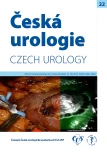Extraperitoneal robotic radical prostatectomy with bilateral sparing of neurovascular bundles
Authors:
Eva Hoření 1; Milan Čermák 1; František Chmelík 1; Jiří Heráček 1,2; Jiří Kočárek 1,2
Authors‘ workplace:
Urologické oddělení, Ústřední vojenská nemocnice - Vojenská fakultní nemocnice, Praha
1; Urologická klinika, 1. lékařská fakulta, Univerzita Karlova, Praha
2
Published in:
Ces Urol 2018; 22(2): 84-86
Category:
Video
Overview
Introduction:
Sparing of the neurovascular bundles is a standard part of radical prostatectomy in selected patients with prostate cancer. At our department we indicate a bilateral nervesparing procedure in patients with clinical stage T1c, PSA ≤ 10 ng/ml and Gleason score (GS) ≤ 6. Unilateral preservation of neurovascular bundles is performed in patients with GS score 7–8, biopsies with tumor on one side only and in nonapical location, with no perineural invasion or palpable disease. Selected patients underwent preoperative magnetic resonance imaging of the pelvis. In the set of 1,500 robotic radical prostatectomies in the period 2005–2015, we performed 659 (43.9 %) nerve-sparing procedures. The postoperative recovery of erectile function was evaluated in 447 29.8 %) patients. One year from the surgery 247 (55.3 %) men were capable of a sufficient erection for sexual intercourse without any supportive therapy.
Description of the clinical case:
We present the technique of extraperitoneal robotic nervesparing radical prostatectomy in a 64-year-old man with bioptically verified prostate adenocarcinoma cT1c Nx Mx, GS 3 + 3, iPSA 3.8 ng/ml, 3/12 positive biopsy cores, prostate volume: 35 ml and IIEF 20. Procedure starts in the 30° Trendelenburg position by digital preparation of the preperitoneal space followed by the insertion of three 8 mm robotic ports, a 12 mm assistant port and a videoport located in the subumbilical incision. We separate the prostate from the bladder neck without ligation of the dorsal vein complex and without the preparation of the endopelvic fascia on the sides of the prostate. We release the seminal vesicles and interrupt the ducts. Pedicles are controlled on both sides with 5mm titanium clips and then interrupted. Neurovascular bundles are saved bilaterally with preserving the prostatic fascia with cavernous nerves. The dorsal vein complex is ligated and fixed to the symphysis. Under the apex, the urethra is interrupted, the urethrovesical anastomosis is sewn to the continuing V-loc stitch in one layer. The operation time was 115 minutes, the blood loss was 100 ml. The patient was discharged home on the 4th day after surgery. We removed the urinary catheter on the 7th postoperative day. Histopathological examination confirmed prostate adenocarcinoma pT2, GS 3 + 4, R 0. The patient reached full urinary continence within 1 week after removal of the urinary catheter, and was able to have intercourse with 5 mg tadalafil per day within 6 weeks. Evaluation of erectile function 12 months after surgery demonstrated 95% return of erection (IIEF 19) without PDE5 inhibitor support.
Conclusion:
Robotic radical prostatectomy is a minimally invasive, reliable and safe method of treatment of indicated prostate cancer patients. The technique of bilateral neurovascular bundle sparing allows almost complete return to the preoperative state of erectile function and has a significant impact on the quality of life of the patient after surgery for prostate cancer.
KEY WORDS:
Prostate cancer, robotic radical prostatectomy, erectile function, miniinvasive approaches, IIEF-5.
Sources
1. Kočárek J, Heráček J, Čermák M, Chmelík F, Matějková M. Roboticky asistovaná radikální prostatektomie – výsledky u 1 500 operací. Rozhl Chir 2017; 92(2): 75–81.
2. Kočárek J, Belej K, Chmelík F, et al. Nervy šetřící roboticky asistovaná antegrádní radikální prostatektomie se šetřením prostatické fascie (Afroditina závoje). Ces Urol 2014; 18(Suppl 1): 58.
3. Hora M, Stránský P, Ürge T, et al. Laparoskopická extraperitoneální radikální prostatektomie nervy šetřící – video. Ces Urol 2017; 21(4): 268–271.
4. Ficarra V, Novara G, Ahlering T, et al. Systematic review and meta‑analysis of studies reporting potency rates after robot‑assisted radical prostatectomy. Eur Urol 2012; 62 : 418–430.
5. Broul M, Štrbavý M, Skála P. Hodnocení erektilní dysfunkce po roboticky asistované radikální prostatektomii. Ces Urol 2014; 18 : 324–333.
6. Doležel J, Tvarůžek J, Staník M, et al. Our early experience with roboticassisted laparoscopic radical prostatectomy – first 153 cases. Ces Urol 2009; 13(2): 168–177.
Labels
Paediatric urologist Nephrology UrologyArticle was published in
Czech Urology

2018 Issue 2
Most read in this issue
- Mondor’s penile disease – our results
- MRI ultrasound fusion biopsy in the diagnosis of prostate cancer
- Usage of indocyanine green in urological robotic surgery
- A rare case of eosinophilic funiculitis
